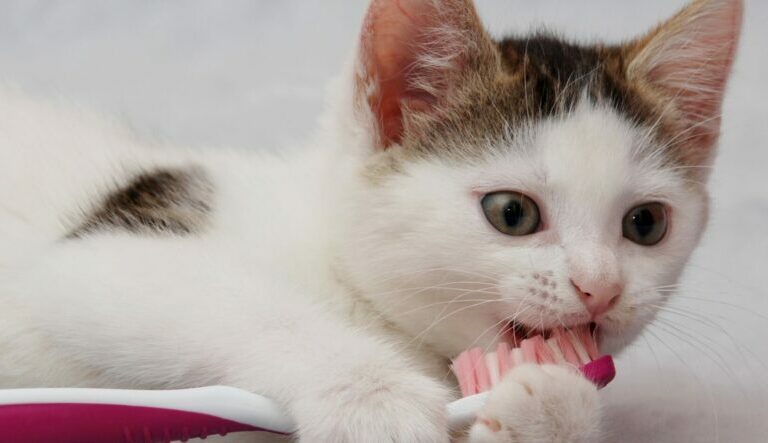
Periodontal Disease in Cats
Posted: 02/15/2023 | Categories: Common problems in cats
Periodontal disease is one of the most common diseases that affects cats and is pretty easy to spot and prevent. It can become a severe disease in untreated cases, and cause irreversible damage to your cat’s teeth so it’s good to be aware of the symptoms and consult your vet if you are at all concerned.
What is periodontal disease?
Periodontal disease is the inflammation of the structures of the mouth as a result of a bacterial infection. This disease has several stages and is extremely preventable!
The first stage is merely a build-up of sticky plaque on the teeth and the development of tartar deposits(also known as calculus), as well as inflamed gums. Plaque and tartar are conditions we can suffer from too, and tartar is fairly easy to spot on your cat’s teeth as it is yellow or brown in color. It can appear first on the back molars and if left untreated can cause gingivitis (gum disease). Gingivitis is where the gums are in state of permanent inflammation due to the bacterial build-up on the teeth.
If no action is taken the disease can then become full blown periodontal disease, which will cause irreversible damage. At this stage in the disease you cat’s teeth can start to come loose. When this happens spaces form under the teeth, creating a breeding ground for more bacteria. This can lead to bone loss, tooth loss, tissue destruction in the gums and the build-up of pus in the cavities between the gums and teeth. In extreme cases the weakening of the jaw can result in a jaw fracture from a surprisingly small amount of pressure.
The final stage is considered to be severe periodontis, marked by bone or tooth loss in the animal. In this case, there is at least a 50% loss of attachment in the affected teeth, and the gum tissue is usually receding and exposing the roots of the teeth.
What makes this a common health issue in cats?
Your cat may be more susceptible to periodontal disease if they are:
- An older cat. This disease is more frequently found in older cats. It is also more commonly found in cats with the calicivirus, FIV, or feline leukemia virus.
- Genetically predisposed to gum disease. Some cats, such as the Oriental short-hair and Siamese cats are genetically more likely to develop periodontal disease, regardless of life stage. This is also true of some purebred cats, showing that genetics can play a role too.
- Eating a diet that puts them at risk. Hard kibble is generally better than soft food at keeping plaque from accumulating. There are also special diets available that are designed to assist with dental health and prevent the formation of plaque.
- Longer haired or groom themselves a lot. The accumulation of hair around teeth can lead to more plaque forming on teeth.
How can I spot signs of periodontal disease?
It’s quite unusual for pet owners to notice early signs of gum disease in their cat, and usually by the time it is noticeable the disease can be quite advanced. As the disease in its late stages is almost irreversible, it is important to get your cat’s teeth checked at least once every 6 months by your vet. You can look for signs of the disease between veterinarian visits, so it is caught as early as possible. Watch out for signs such as:
- Swollen or reddened gums, that may or may not bleed easily, especially at the back of the mouth
- yellow or brown teeth and loose or missing teeth
- Smelly breath
- A loss of appetite or trouble eating and weight loss
- Pawing at the face
- Stomach or intestinal issues
- Drooling
- Difficulty chewing or eating
- Irritability or depression
- Pus around the teeth
- A sensitive mouth
How can you prevent periodontal disease?
The best way to combat gum disease is to fight to prevent it in the first place.
Visiting your veterinarian for regular checks and building good habits early on could save you and your furry friend no end of woe down the line!
Visit your local veterinary practice regularly
Get regular checks. Some practices offer a professional dental cleaning service so talk to your local practice about how to arrange a session for your cat.
This can involve multiple procedures to improve dental health, so be sure to speak to your practise about the specific issues facing your pet and the options available.
Examples include:
- Inspect, clean and polish your cat’s teeth under sedation
- Prescribing antibiotics for diseased gums
- Dentistry work under anaesthetic to remove diseased teeth and repair damage
These sorts of procedures will also usually involve a process of aftercare and your dedication to this aftercare process will be crucial for the continuing health of your cat.
Brush your cat’s teeth
If you veterinarian recommends it, you may want to try to brush your cat’s teeth at home. While many may think that brushing your cat’s teeth may be uncomfortable for your cat, they can enjoy it as a new form of attention. If your cat does not enjoy it, ensure your vet inspects you cats teeth regularly and get them to clean their teeth under sedation. This is less stressful for your cat and will ensure the vet can do a thorough inspection and clean and give you full advice on how to manage the condition in the future.
Food
It is possible to purchase cat food and treats that have been specifically formulated to help fight dental disease and if needed your vet will be able to advise you on what to buy.